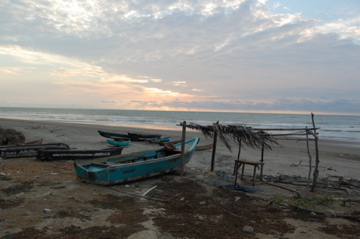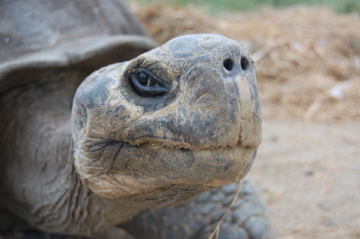On arriving in the Pacific coastal town of Bahía de Caráquez after a nine-hour downhill coach journey from Ecuador’s Andean capital Quito, you are presented with a choice: opt for the conventional and ubiquitous yellow cab to reach your accommodation in a matter of minutes, or use the ambling and environmentally-sound ‘eco-taxi’.
This local invention can also be described as a covered and reversed version of the rickshaw. But that takes away the charm of thinking that you are helping the environment rather than enjoying colonial-style transportation. Unlike their Asian counterparts, the bicycle is placed at the back and pushes an unnaturally large two-wheeled cabin in which excited tourists sit and enjoy views of oncoming traffic and the Pacific Ocean. These small wonders are in constant circulation around the seafront and all ‘eco-taxi’ operators, after a ritualistic bout of haggling, are ever ready to take you wherever you wish to go, be it ice cream shop or beach, as long as you are in no rush whatsoever.
Bahía de Caráquez is roughly 50km south of the equator and lies in the province of Manabí. It is famous for its shrimps, empty high-rise apartment blocks and its status as an ‘Eco-Ciudad’. This title was awarded in 1997 after it was destroyed by a brutal and now infamous storm. This reinvention after such devastation is testament to the instantly infectious and effervescent character of the costeños. It is impossible not to be struck by the ceaseless optimism of the people who successfully ensured Bahía did not remain a site of destruction for long. The Eco-Ciudad status has boosted the local economy and attracted a new breed of tourist; one which helps to add to the work of those in Bahía and support the environment and community.
At an acceptable distance from the capital Quito (nine hours – relatively easy in a country where one has to tackle one the world’s largest mountain ranges to get to most places) Bahía once provided a relaxing getaway for the influential. As soon as the former President invested in a holiday apartment here,Quiteños and the middle classes copied him in their droves. The remnants of this short-lived boom can be seen today in the form of white tower blocks, which line the sea front and form a distinctive part of the view of the city from the surrounding hills.
Nowadays, for gringos it provides a stop off on the way to the surf magnet of Canoa an hour up the coast, which after seeing Bahía, seems like a mini Bangkok tucked away beneath surf shacks and milkshake shops. If your idea of a South American adventure does not involve eating vegetarian pizza and meeting Canadians, however, then you can also book surfing lessons in Bahía, which holds more than 3 hours on the waves, with the wayward surf instructor Enrique - ‘pero las chicas guapas me llaman Ricci’.

Cerro Seco biological reserve lies past the range eco-taxis in the community of Bellavista, with its brightly coloured shacks, although admittedly it seems only colours of the national flag - yellow, blue and red – are available. A small school where volunteers give English lessons holds classes on seemingly few days when there is no national holiday, no teacher’s strike, no teacher training, no community meeting or no confusion over the exact date of any of the above. This relaxed system no doubt contributes to the invariably friendliness of local who, while working hard, enjoy the relaxed pace of life in the village.
The students from the school in the village and those from a number of schools in the town often visit Cerro Seco for educational walks around the tracks, built and maintained by volunteers who come from all over the world. The principal aim of Cerro Seco and Marcelo Luque (owner only in name, as he insists the earth belongs to us all) is to educate the younger generation of the importance of sustainable living. This can be achieved through planting trees by the students in the forest, as well as the creation of a garden in their school playground, so the children can be actively involved in the development of their local environment. (It also served as a useful distraction to oversized classes who had absolutely no interest in sitting in their seats and learning English; digging seemed a much more feasible method of drumming at least the word ‘garden’ into them.)
While advertising itself as an ‘Eco-ciudad’ Bahía de Caráquez has plenty to offer tourists as Ecuador’s rich ecological diversity is not just limited to the sliver of Amazon rainforest in the east. One morning in Cerro Seco’s dry forest was enough to open my eyes to this spectacular diversity. With a small group of school children we entered the forest, trying hard to field their biological questions about what leaves were really made from, and the Latin names for the smallest of flowers and plants. We lugged containers full of water up the hill to replenish the trees planted the week before, by their younger classmates. On arriving at the recently cleared campsite at the top of the hill we stumbled across a family of vultures who had appropriated it as their own. The mother of two yellow, fluffy fledglings seemed more concerned about her own safety and took off above the trees leaving her children, who had yet to develop an aptitude for flying and hopped like gigantic clockwork toys off into the dense trees.
We continued along the ridge and felt as though we had traversed the breadth of Ecuador. The dry forest’s crunching leaves turned into tropical Amazon, and within five minutes 78 bites spread over my four limbs. This travesty on the muggy slope did not come without reward: on finding a familiar sandy track that led back to Cerro Seco we came across a family of anteaters - a rare sight that the residents of Cerro Seco had never seen.

The surrounding region of Bahía also contains an abundance of blossoming businesses geared towards an expected influx of eco-tourists who are looking for something beyond the ‘Bob Marley’ tourism that is neighbouring Canoa. These include tours of the bird watchers paradise Isla de Corazon, the organic farm Rio Muchacho, run by international volunteers and tours of a nearby mangrove swamp led by enthusiastic guides with ever-increasing levels of English.
It is unfortunate that tourists generally neglect Bahía on a journey through Ecuador, as it is overshadowed by ‘big name’ experiences available elsewhere such as the Galapagos, whale-watching further down the coast, the volcano Cotopaxiin the centre and trips into the mysterious Amazon further east. However, Bahía can offer that rare experience of relative seclusion yet unparalleled hospitality with its quiet guesthouses, bustling daily fruit markets and long beaches inhabited only by startled creatures. The people of Bahía welcome tourism, but are intent on creating something separate from the existing structure which has arguably harmed the beauty of Ecuador.
I arrived a British cynic who thought eco-tourism was an oxymoron, an impossible ideal unattainable because of the inherent selfishness necessary in travelling. But after living at Cerro Seco, attending council meetings and discussing the future of the area with those who care, I have been infected with Ecuadorian optimism. It is not the eventual outcome but the change in attitude that matters; arriving on time in a conventional taxi counts less than using one powered by sheer good will, a sustainable vision of the future and a strong pair ofcosteño legs.
Useful information:
Reserva Biologica Cerro Seco, emailmarcelo_luque@hotmail.com for information and availability ($250 per month covers all accomodation and food and volunteers are welcomed at any time of year for any duration over one month)
Planet Drum, a US run conservation organisation located in the centre of town www.planetdrum.org/eco_ecuador.htm
Coco Bongo, the most popular hostal in town. A friendly, cheap magnet for yacht owners from all over the world and also host to salsa lessons, barbeques and meeting point for volunteers. info@cocobongohostal.com
La Piedra Hotel Tel. (593) 052690780. Slightly more upmarket for a relaxed week on the seafront. (Rooms start at $65 for doubles)
Rio Muchacho Organic Farm, very popular and well run organisation catering for volunteers from all over the world. About an hour from Bahia once you cross the Estuary to San Vicente. www.riomuchacho.com
Buses run from Quito through the company Reina del Camino. Buy tickets in advance from the corner of 18 de Septiembre and Avenida Patria. The journey takes 8-9 hours and costs $9 (bus tickets in Ecuador usually cost $1 per hour of travel). Services run day and night. To arrive from other locations bus travel is efficient and easy. All towns have loud and busy bus stations with frequent services going all over Ecuador.













